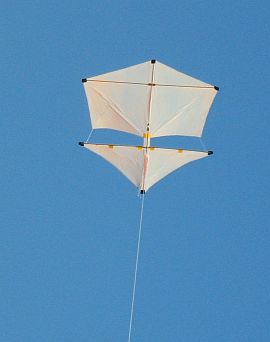- Home Page
- Flight Reports
- Sticked Rollers
- 2-Skewer Roller
2-Skewer Roller Kite
Long High Flight in Perfect Weather
The 2-Skewer Roller kite seemed a good choice, since it was a classic light-wind-and-thermals day.
 MBK 2-Skewer Roller
MBK 2-Skewer RollerOnce we arrived at the reserve, it didn't take long to float the roller out to a line length of about 15 meters. From there, a bit of line pulling got it up a little higher where there was just enough breeze to keep it airborne.
When the roller touched the ground a few times during lulls, four-year-old Aren helped to relaunch the kite. He now knows how to hold it by the bridle and let it go when the wind catches it.
Now it was time to fly much higher!
It was straightforward to slowly let out line for a while. The 2-Skewer Roller climbed smoothly, maintaining a 40-degree flying angle. Soon it was passing through 100 feet, and we started walking back toward the perimeter fence, upwind.
Having forgotten our sun hats, it was good to notice a large shady tree quite close to where we were headed! Maybe we could fly a bit longer after all, without getting fried by the UV.
Meanwhile, the kite was still maintaining 40 degrees although the line was going out quicker now.
On this site, there's more kite-making info than you can poke a stick at. :-) Want to know the most convenient way of using it all?
The Big MBK E-book Bundle is a collection of downloads—printable PDF files which provide step-by-step instructions for many kites large and small.
That's every kite in every MBK series.
We reached the low log fence and sat on it, while the kite parked itself at a 45-degree angle. Mind you, there was a lot
of sag in the line due to the very light winds. Even then, I decided to
let out the remaining few meters until nearly all 150 meters of line
was out.
The line tension was quite low most of the time but slowly went up and down in response to wind speed and thermal activity. Accordingly, the 2-Skewer Roller kite slowly rose and fell, flying at between 30 and 55 degrees. The amount of sag in the 20-pound line varied a lot too. In these conditions, a 10-pound line would probably have been safe enough. The average wind speed was probably somewhat less than the ideal for this kite.
Eventually, there were some of the usual clues that a stronger patch of rising air was in the vicinity. After all, the time was heading toward midday. A fluffy seed passed by at shoulder height. The 2-Skewer Roller kite seemed to encounter choppy air—sinking one minute, soaring up the next.
Another fluffy seed made an appearance, at 100 feet altitude, and it wasn't going down! Maybe now...
Sure enough, after a while the line really tightened and the little roller climbed like a homesick angel, with a hint of trailing edge flutter. The kite peaked at about 55 degrees, its highest level of the entire flight, at just over 400 feet up. Perhaps the middle of the thermal was way off to one side, since the kite dropped back down to 45 degrees after less than half a minute.
And perhaps it was a skinny thermal, since winter is not far away. As an ex-sailplane pilot, I remember climbing in some rather narrow and turbulent thermals near Alice Springs in the N.T.
A while later, having seen the 2-Skewer Roller kite have a good long high flight, I decided to bring it down. Walking slowly back to where the car was parked, I wound on line whenever the line tension dropped a little. Down came the kite, right into my hand without touching the grass.
If you're new to this site, have a guess which country I'm in. Here's a clue; these other flying objects kept the kite company at various times:
- 20 galahs
- 9 magpies
- a passenger jet heading east after taking off from Adelaide airport
Don't worry, the jet was at several thousand feet!
The story or stories above document actual flying experiences. My write-ups are definitely "warts and all," since things don't always go totally as planned. However, half the fun of kiting is anticipating the perfect flight. When it happens, it's magic!
As mentioned earlier, there's more kite-making info here than you can poke a stick at. :-)
Want to know the most convenient way of using it all?
The Big MBK E-book Bundle is a collection of downloads—printable PDF files which provide step-by-step instructions for many kites large and small.
That's every kite in every MBK series.
